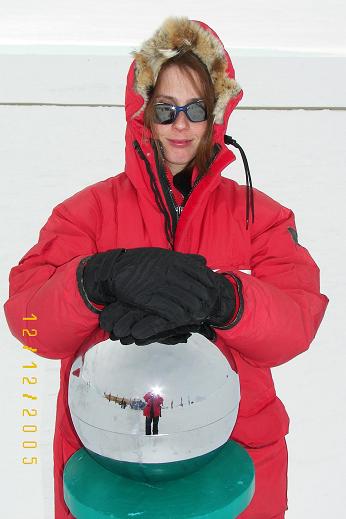Dr. Hagar Landsman is the only Israeli participating in the "iScube" project

"During my studies at the Physics Faculty at the Technion, under the guidance of Professor Yoram Rosen, I presented to the students the 'Ayskiv' project being conducted at the South Pole. In one of the slides, physicists wrapped in red coats were seen installing detectors at the pole. I did not imagine then that in a short time I would be one of these scientists." Says Dr. Hagar Landsman, who stays in difficult conditions at the South Pole and participates in the unique research.
"Ayskiob" is a neutrino telescope used for astrophysical research. Neutrinos are elementary particles created in astrophysical processes. "Their uniqueness is that they react with matter with a very low probability, and are therefore able to travel vast distances without being swallowed and bring us information about astrophysical phenomena," explains Dr. Landsman. "To increase the chance of measuring neutrinos, we need a very large detector. If we are lucky and the neutrino reacts with the material, a charged particle is created that moves above the speed of light in the material, emitting weak light. Measuring this weak light in a light-impermeable detector indicates the existence of the neutrino. Therefore, to build a neutrino detector, we need a lot of transparent and dark material, for example - ice at a great depth, and there is nothing like Antarctica for this purpose."
The "Ayskiov" detector is currently being built at the South Pole, and when its construction is completed in a few years, it will consist of an array of 5,000 light detectors that will be spread over a volume of a cubic kilometer. With the help of a special drill, Dr. Landsman and her colleagues drill holes with a huge depth of two and a half kilometers in the ice, and into them they chain a chain of detectors. Each such pit contains 60 sensitive light detectors, each of them the size of a basketball and weighing about 15 kilograms. To perform a correct analysis of the data, the detectors must be characterized and their characteristics and the information they provide must be known. Moreover, once the detectors are inside the ice, they cannot be replaced or repaired, so the scientists must verify their quality before installation. Dr. Landsman is responsible for testing the detectors before sending them to the pole, and for testing them again on the ice. This role brought her to the South Pole for the second year. In addition to testing, it also deals with analyzing the collected data and checking its quality while comparing it to simulation and theoretical predictions, and separating the signals from the background. In recent months, she has also been involved in the development of the next generation of neutrino detectors, based on radio detectors.
"The conditions here are not easy", she says. "The cold is intense, it is very dry here and there is not enough oxygen. At this time of the year there is bright daylight all day, the rooms are tiny (1x3 meters) and you can only shower twice a week, two minutes each time. Getting here is difficult, and at best takes four days, subject to weather conditions. Telephone and email contact with the world is limited to the time when a satellite is above us. But thanks to the scientific challenge, I overcome the difficulties, like the 200 wonderful people who staff our remote research station."
Dr. Landsman's husband, Adi, also a Technion graduate, takes care of their little daughter Tamar, with the help of the mother-in-law who comes to help him in Wisconsin. Tamar cannot explain what brings her mother to the South Pole, so she proudly tells that her mother takes care of penguins. "For some reason the penguins speak more to the hearts of toddlers than neutrinos," laughs Dr. Landsman.
In the photo: Dr. Hagar Landsman at the South Pole

3 תגובות
An abnormal drink
Grrrrrrr…. Hagar…….one of the cutest girls that appear on the computer screens of freshmen at the Technion
Align power!